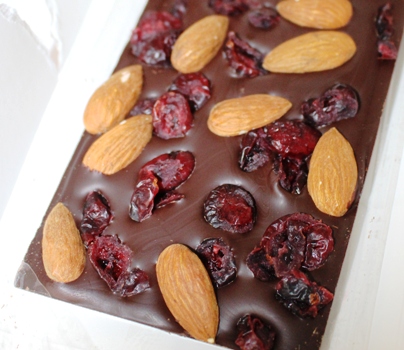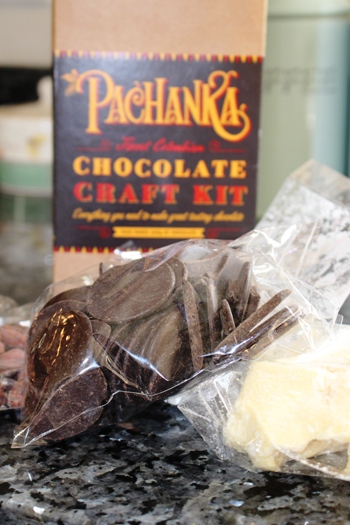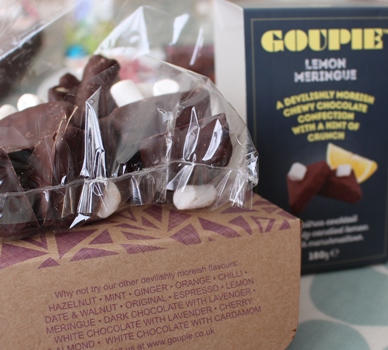An Introduction to 'Real' Chocolate
Ever since I can remember I have never turned down the offer of chocolate. It's always been the brands everyone would recognise - and there is nothing wrong with that! I have always enjoyed a Terry's Orange 'tap and crack'’, or polishing off a Toberlerone.
Personally, I have always found white chocolate very sweet. I have never been a 'milky bar kid' and that was always the last chocolate in the box to be eaten, next to anything with coconut!
However, this Easter my family has been subjected to real chocolate education. Don't get me wrong there were still some Cadbury's Dairy Milk eggs in the basket but also a selection of some unusual packages and not so well known brands. Has the Easter bunny been converted?
It all started a few weeks ago when I went over to Denbies Wine Estate. Discover Cacao was organising a Chocolate Fair and I was fortunate enough to meet with a select group of fine chocolatiers including Rococo, Lococoa, Solkiki, Fifth Dimension Chocolates and The Chocolatier Aneesh Popat - to name a few. After speaking with these knowledgeable experts I began to realise I knew very little about real chocolate and all I can talk about is a candy bar.
I found out that legally in the EU for a product to be called chocolate it needs to contain more than 30% of cocoa and, of course, the commercial chocolate I have been quite happy with only just passes that mark. Like so many people, I have stayed clear of very dark chocolate as I have had experience of it tasting quite bitter. This is the most common reason people are against exploring chocolate further.
Yet, if you drink a bad cup of coffee and you find the coffee bitter it's because the bean has been burnt - and it is exactly the same for chocolate. I cannot believe I have gone through at least 20 years missing out.
Understanding where the chocolate comes from and after hearing the story of bean to bar, naively I have never thought of chocolate like this before. 
Cocoa beans need to be harvested, fermented, dried, cleaned and roasted. After being roasted, the beans are crushed to release the internal nib from their shells. Then there is further crushing and grinding and then finally conching and tempering.
Tasting the nib was like experiencing the REAL chocolate nut - where it all starts.
I have to admit that I left that chocolate fair not only with a huge bag of delicious purchases but also with the excitement that chocolate was good for you. For me I hadn't just read about chocolate being nutritious - I had learnt why, I now understood the benefits. Chocolate can be paired with so many foods and flavours and now I needed to expand my knowledge and learn how to taste chocolate properly.
At the Oxted Chocolate Fair on the 19th March 2016 I was helping with the coffee, teas and hot chocolates in the cafe. Kokoa Collection supplied their curious chocolate buttons in 58,70,75 and 78% chocolate. To make this smooth and rich chocolate drink you dissolve 3-4 buttons in a cup with a little boiling water. Once the chocolate is melted you add hot milk but not heated above 70 degrees as you don't want to burn the chocolate. It really is quite a different chocolate drink, I highly recommend tasting it and am sure I will find it difficult to go back to any of the other powders I am used too.
I have been up to food fairs in London since and now my eyes have been opened I have been much more focused on chocolate. I met the Duke of Delhi and their amazing dark chocolate infused with unusual spices, along with Trofflechocs, which are beautiful handmade chocolates, with added home-grown ingredients, inspired by the spice markets of the Eastern Mediterranean.
I have also tried my hand at making my own chocolate with Pachanka's Finest Columbian Chocolate Craft Kit - which turned out well. One batch was made with a natural sweetener and the other with icing sugar.
What I slowly started to understand was that appreciating the tastes behind the chocolate was comparable to tasting fine wines, yet it is all a much slower, more sedate and 'grown up' experience.
Firstly the tasting has to be done in a calm, maybe quiet environment and it should be a comfortable temperature not too hot or cold. You choose with your eyes - which chocolate appeals the most? The prettiest, the most colourful, the one with something nice on the top? It's true, your eyes are the first to satisfy.
At our chocolate tasting session we were all immediately drawn to Solkiki's raspberry white chocolate, with such a great vibrant pink colour. I have never compared chocolate before but looking at a plate of different brands, quality, types - they vary so much in colour, from rich reds to dark browns.
Touching chocolate is also something I have not been comfortable doing, as it would normally melt and get sticky. Again better chocolate should appear smooth, maybe glossy or shiny. When I picked up the chocolate to break it I would also be hoping for some early hints of flavour and aromas. Just like you smell a glass of wine, you smell the chocolate and hope for fruit, flowers or nutty aromas and more.
Then it's all about the snap. As I understand, the better the chocolate, the better the snap. You want a sharp, crisp, even brittle snap. I have experienced dull and nearly bendy bars of chocolate in the past.
Putting a small piece of chocolate in my mouth I waited for it to start to melt. This can take a few minutes but it is worth the wait. Once it's a liquid, starting at the front of the tongue (where most of your taste buds are) and move it all round the mouth and under the tongue. Do you get sweet, sour, fruit, nuts?
Most of the chocolates I have tasted so far in this tasting are a great balance, with no bad after-taste. I certainly realise it would be a sin to crunch and swallow this type of chocolate! I have read somewhere that some chocolate can stay with you as long as 45 minutes, I haven't had that piece yet but its still out there for me to find.
And while we are on the finding subject I think that the Easter bunny has been educated rather than converted. I now know what to look for in better chocolate, and it is not just about the size of the egg!
Mollie's Chocolate Blog
My daughter, Mollie, joined us for the tasting and recorded her experience from the view of someone much younger.
"When your a child you don't realise what is in your chocolate but I have found out a lot about what is in the real thing compared to what I thought was good chocolate.
I have been testing and learning what is real chocolate and what is 'bad' chocolate. Real chocolate is simply just cocoa beans and a bit of cocoa butter, which surprised me.
'Bad' chocolate is the chocolate that is so processed and has so many additives, around 4 percent of cocoa and about 30 percent of sugar, compared to the dark, good chocolate with 70 percent of cocoa and low levels of sugar. Quite unbelievable.
I also have learnt how to taste chocolate products properly. First I had to sniff and snap the bar to smell the scent of the chocolate and then I had to let the block of chocolate melt in my mouth so that I could let all my taste buds feel and taste the chocolate, which gave me a lovely after taste.
All in all, I learnt a huge amount about chocolate and I now know how to taste and find the good chocolate, which unfortunately might not be in my local supermarket.
Remember, all you have to do is look at the percentage of the cocoa and then you may have found good healthy chocolate."